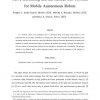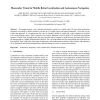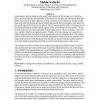717 search results - page 11 / 144 » Autonomous mobility skeletons |
CORR
2006
Springer
13 years 7 months ago
2006
Springer
If a smooth, closed, and embedded curve is deformed along its normal vector field at a rate proportional to its curvature, it shrinks to a circular point. This curve evolution is ...
FUZZIEEE
2007
IEEE
14 years 1 months ago
2007
IEEE
— The type-2 Fuzzy Logic Controller (FLC) has started to emerge as a promising control mechanism for autonomous mobile robots navigating in real world environments. This is becau...
IJCV
2007
13 years 7 months ago
2007
This paper presents a new real-time localization system for a mobile robot. We show that autonomous navigation is possible in outdoor situation with the use of a single camera and ...
AROBOTS
2008
13 years 7 months ago
2008
Autonomous mobile robots need to adapt their behavior to the terrain over which they drive, and to predict the traversability of the terrain so that they can effectively plan thei...
TIFS
2008
13 years 7 months ago
2008
In autonomous mobile ad-hoc networks, one major challenge is to stimulate cooperation among selfish nodes, especially when some nodes may be malicious. In this paper, we address co...



